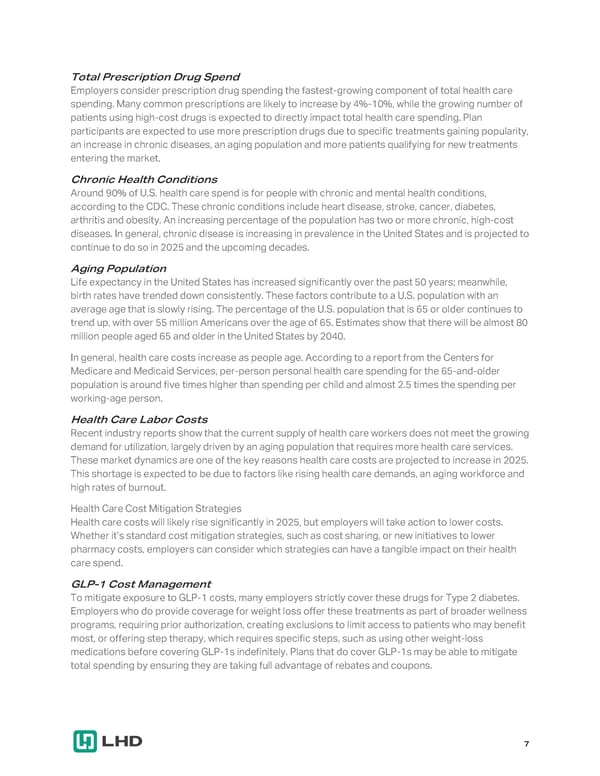Total Prescription Drug Spend Employers consider prescription drug spending the fastest-growing component of total health care spending. Many common prescriptions are likely to increase by 4%-10%, while the growing number of patients using high-cost drugs is expected to directly impact total health care spending. Plan participants are expected to use more prescription drugs due to specific treatments gaining popularity, an increase in chronic diseases, an aging population and more patients qualifying for new treatments entering the market. Chronic Health Conditions Around 90% of U.S. health care spend is for people with chronic and mental health conditions, according to the CDC. These chronic conditions include heart disease, stroke, cancer, diabetes, arthritis and obesity. An increasing percentage of the population has two or more chronic, high-cost diseases. In general, chronic disease is increasing in prevalence in the United States and is projected to continue to do so in 2025 and the upcoming decades. Aging Population Life expectancy in the United States has increased significantly over the past 50 years; meanwhile, birth rates have trended down consistently. These factors contribute to a U.S. population with an average age that is slowly rising. The percentage of the U.S. population that is 65 or older continues to trend up, with over 55 million Americans over the age of 65. Estimates show that there will be almost 80 million people aged 65 and older in the United States by 2040. In general, health care costs increase as people age. According to a report from the Centers for Medicare and Medicaid Services, per-person personal health care spending for the 65-and-older population is around five times higher than spending per child and almost 2.5 times the spending per working-age person. Health Care Labor Costs Recent industry reports show that the current supply of health care workers does not meet the growing demand for utilization, largely driven by an aging population that requires more health care services. These market dynamics are one of the key reasons health care costs are projected to increase in 2025. This shortage is expected to be due to factors like rising health care demands, an aging workforce and high rates of burnout. Health Care Cost Mitigation Strategies Health care costs will likely rise significantly in 2025, but employers will take action to lower costs. Whether it’s standard cost mitigation strategies, such as cost sharing, or new initiatives to lower pharmacy costs, employers can consider which strategies can have a tangible impact on their health care spend. GLP-1 Cost Management To mitigate exposure to GLP-1 costs, many employers strictly cover these drugs for Type 2 diabetes. Employers who do provide coverage for weight loss offer these treatments as part of broader wellness programs, requiring prior authorization, creating exclusions to limit access to patients who may benefit most, or offering step therapy, which requires specific steps, such as using other weight-loss medications before covering GLP-1s indefinitely. Plans that do cover GLP-1s may be able to mitigate total spending by ensuring they are taking full advantage of rebates and coupons. 7
 2025 Employee Benefits Market Outlook Page 6 Page 8
2025 Employee Benefits Market Outlook Page 6 Page 8